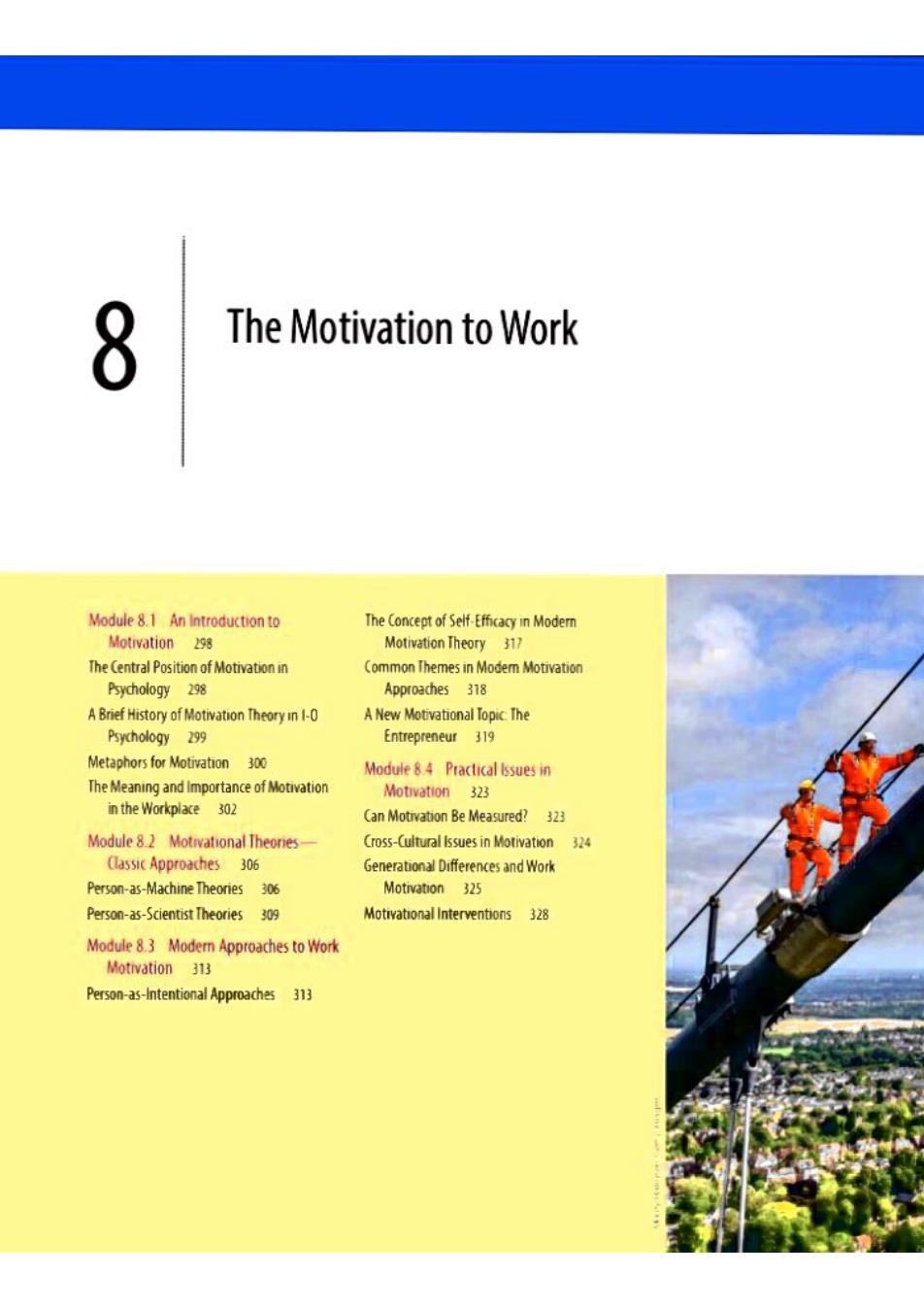
8 The Motivation to Work Module 8.1 An Introduction to The Concept of Self-Efficacy in Modem Motivation 298 Motivation Theory 317 The Central Position of Motivation in Common Themes in Modem Motivation Psychology 298 Approaches 318 A Brief History of Motivation Theory in 1-0 A New Motivational Topic The Psychology 299 Entrepreneur 319 Metaphors for Motivation 300 Module 84 Practical Issues in The Meaning and Importance of Motivation Motivation 323 in the Workplace 302 Can Motivation Be Measured?323 Module 8.2 Motivational Theories- Cross-Cultural Issues in Motivation 324 Classic Approaches 306 Generational Differences and Work Person-as-Machine Theories 306 Motivation 325 Person-as-Scientist Theories 309 Motivational Interventions 328 Module 8.3 Modern Approaches to Work Motivation 313 Person-as-Intentional Approaches 313
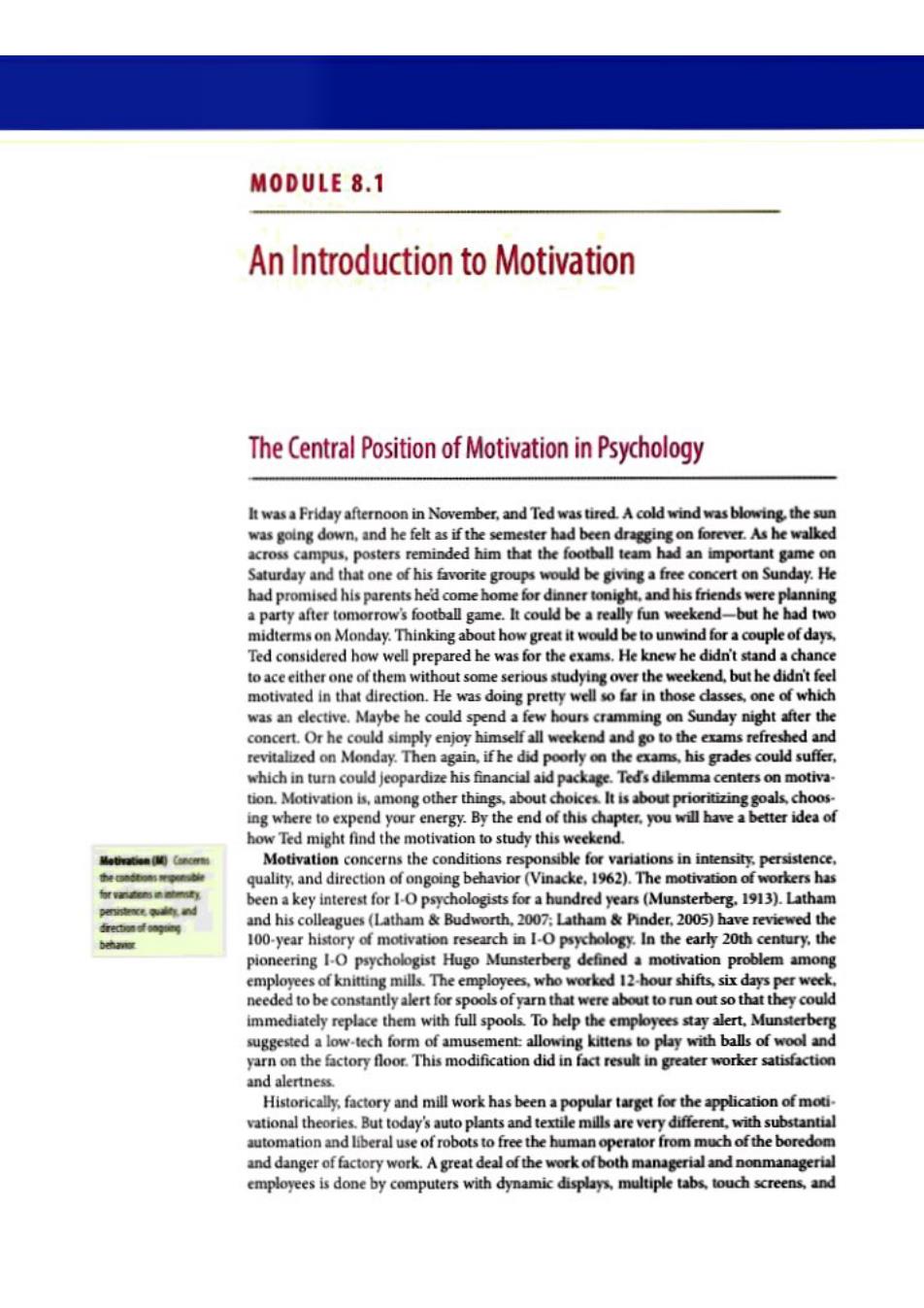
MODULE 8.1 An Introduction to Motivation The Central Position of Motivation in Psychology It was a Friday afternoon in November,and Ted was tired.A cold wind was blowing.the sun was going down,and he felt as if the semester had been dragging on forever.As he walked across campus,posters reminded him that the football team had an important game on Saturday and that one of his favorite groups would be giving a free concert on Sunday.He had promised his parents hed come home for dinner tonight,and his friends were planning a party after tomorrow's football game.It could be a really fun weekend-but he had two midterms on Monday.Thinking about how great it would be to unwind for a couple of days. Ted considered how well prepared he was for the exams.He knew he didn't stand a chance to ace either one of them without some serious studying over the weekend,but he didn't feel motivated in that direction.He was doing pretty well so far in those dasses,one of which was an elective.Maybe he could spend a few hours cramming on Sunday night after the concert.Or he could simply enjoy himself all weekend and go to the exams refreshed and revitalized on Monday.Then again,if he did poorly on the exams,his grades could suffer, which in turn could jeopardize his financial aid package.Ted's dilemma centers on motiva- tion.Motivation is,among other things,about choices It is about prioritizing goals,choos- ing where to expend your energy.By the end of this chapter.you will have a better idea of how Ted might find the motivation to study this weekend. Motivation concerns the conditions responsible for variations in intensity.persistence, quality,and direction of ongoing behavior (Vinacke,1962).The motivation of workers has been a key interest for I-O psychologists for a hundred years (Munsterberg.1913).Latham and his colleagues (Latham Budworth,2007:Latham Pinder,2005)have reviewed the 100-year history of motivation research in I-O psychology.In the early 20th century.the pioneering 1-0 psychologist Hugo Munsterberg defined a motivation problem among employees of knitting mills.The employees,who worked 12-hour shifts,six days per week. needed to be constantly alert for spools of yarn that were about to run out so that they could immediately replace them with full spools.To help the employees stay alert.Munsterberg suggested a low-tech form of amusement:allowing kittens to play with balls of wool and yarn on the factory floor.This modification did in fact result in greater worker satisfaction and alertness Historically,factory and mill work has been a popular target for the application of moti. vational theories.But today's auto plants and textile mills are very different,with substantial automation and liberal use of robots to free the human operator from much of the boredom and danger of factory work.A great deal of the work ofboth managerial and nonmanagerial employees is done by computers with dynamic displays,multiple tabs,touch screens,and
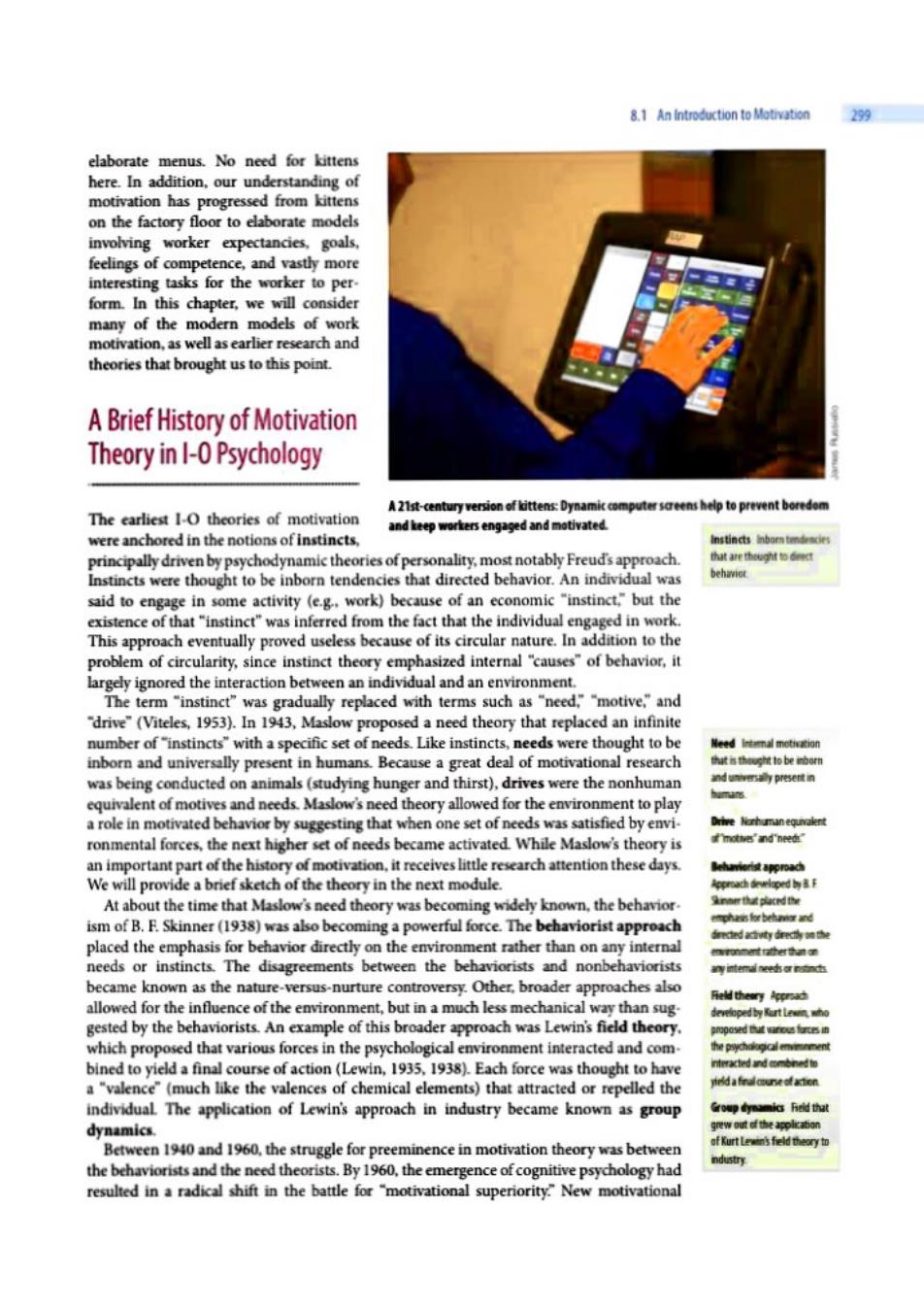
8.1 An Introduction to Motivation 299 elaborate menus.No need for kittens here.In addition,our understanding of motivation has progressed from kittens on the factory floor to elaborate models involving worker expectancies,goals. feelings of competence,and vastly more interesting tasks for the worker to per. form.In this chapter,we will consider many of the modern models of work motivation,as well as earlier research and theories that brought us to this point. A Brief History of Motivation Theory in I-0 Psychology A21st-century version of kittens Dynamic cmputer sreens help to prevent boredom The earliest I-O theories of motivation and keep workers engaged and motivated were anchored in the notions of instincts. instinct电.mnborn tondraci principally driven by psychodynamic theories of personality,most notably Freuds approach. h城ehg的 Instincts were thought to be inborn tendencies that directed behavior.An individual was behaviet said to engage in some activity (e.g.work)because of an economic "instinct."but the existence of that"instinct"was inferred from the fact that the individual engaged in work. This approach eventually proved useless because of its circular nature.In addition to the problem of circularity,since instinct theory emphasized internal "causes"of behavior,it largely ignored the interaction between an individual and an environment. The term "instinct"was gradually replaced with terms such as "need""motive,"and drive"(Viteles,1953).In 1943,Maslow proposed a need theory that replaced an infinite number of"instincts"with a specific set of needs.Like instincts,needs were thought to be Need lntanal motivation inborn and universally present in humans.Because a great deal of motivational research h城指hag线o be born was being conducted on animals(studying hunger and thirst),drives were the nonhuman nd今p时n equivalent of motives and needs.Maslow's need theory allowed for the environment to play a role in motivated behavior by suggesting that when one set of needs was satisfied by envi- Drive Norhmanequvalent ronmental forces,the next higher set of needs became activated While Maslow's theory is f'moties'and'need" an important part of the history of motivation,it receives little research attention these days. hune模approach We will provide a brief sketch of the theory in the next module. Apprach dlaped by At about the time that Maslow's need theory was becoming widely known,the behavior. net出时e ism of B.F.Skinner(1938)was also becoming a powerful force.The behaviorist approach mmphas lor behar and d立有e为烟e placed the emphasis for behavior directly on the environment rather than on any internal needs or instincts.The disagreements between the behaviorists and nonbehaviorists 身tndn动ae本 became known as the nature-versus-nurture controversy.Other,broader approaches also Field theary Agprad allowed for the influence of the environment,but in a much less mechanical way than sug. developed by Kurt Lewn who gested by the behaviorists.An example of this broader approach was Lewin's field theory. p四posed thut wrous faresmn which proposed that various forces in the psychological environment interacted and com- the pychdagical emiment bined to yield a final course of action (Lewin,1935,1938).Each force was thought to have nteracted and eombned to a "valence"(much like the valences of chemical elements)that attracted or repelled the i的firalcuneof action individual The application of Lewin's approach in industry became known as group 金oup dyami Fieid th dynamics. g现out fthe applr动am Between 1940 and 1960,the struggle for preeminence in motivation theory was between of Kurt Lewins feld theory to ndustry the behaviorists and the need theorists.By 1960,the emergence of cognitive psychology had resulted in a radical shift in the battle for "motivational superiority."New motivational
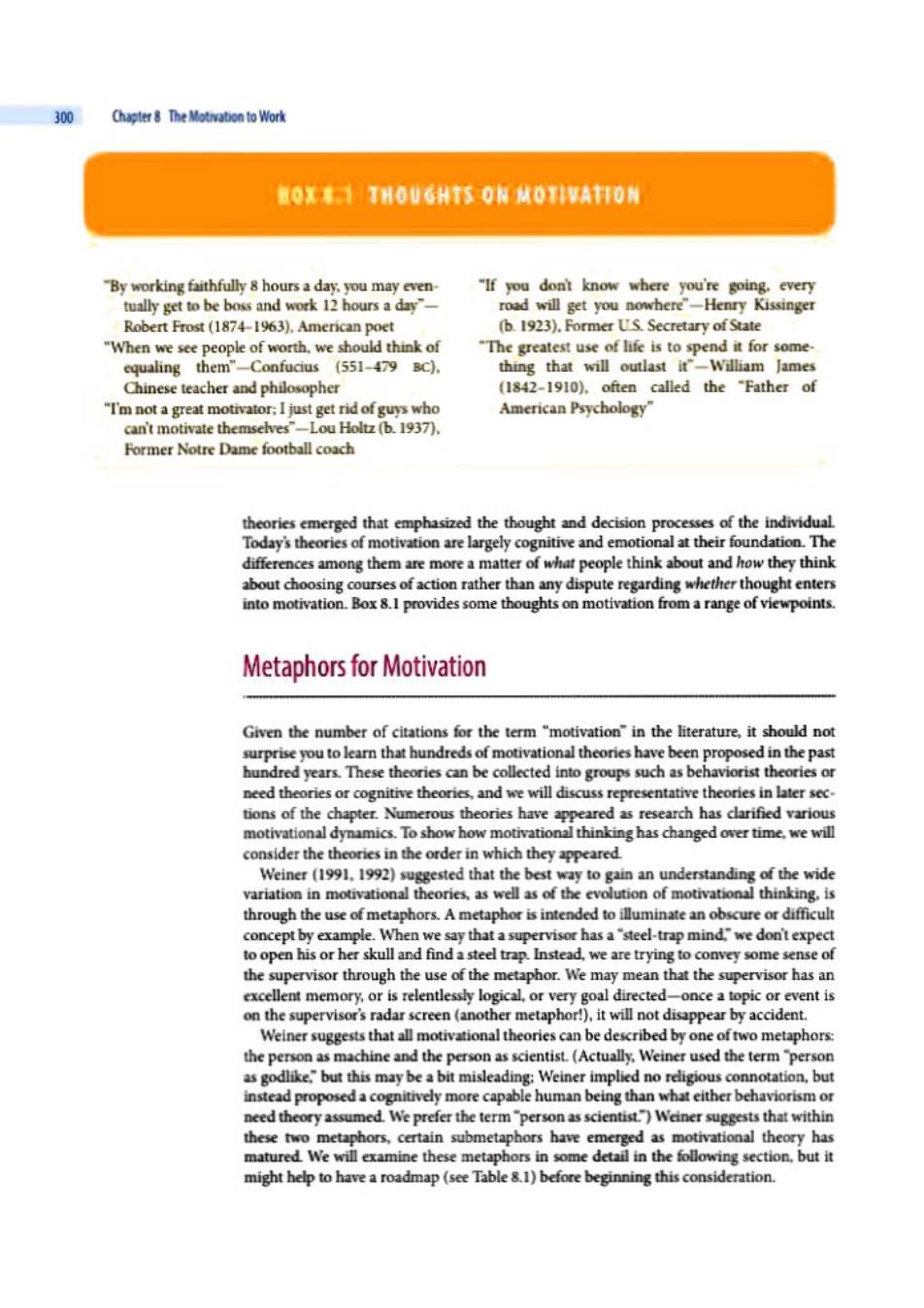
300 Chapter8 The Motivation to Work 题0I1H0U6HT50NM0TyAH0料 "By working faithfully 8 hours a day.you may even- "If you dont know where you're going.every tually get to be boss and work 12 hours a day"- road will get you nowhere"-Henry Kissinger Robert Frost(1874-1963).American poet (b.1923).Former US.Secretary of State "When we see people of worth.we should think of "The greatest use of life is to spend it for some. equaling them"-Confucius (551-479 BC). thing that will outlast it"-William James Chinese teacher and philosopher (1842-1910).often called the "Father of "I'm not a great motivator:I just get rid of guys who American Psychology” can't motivate themselves"-Lou Holtz (b.1937). Former Notre Dame football coach theories emerged that emphasized the thought and decision processes of the individual Today's theories of motivation are largely cognitive and emotional at their foundation.The differences among them are more a matter of what people think about and how they think about choosing courses of action rather than any dispute regarding whether thought enters into motivation.Box 8.1 provides some thoughts on motivation from a range of viewpoints. Metaphors for Motivation Given the number of citations for the term "motivation"in the literature,it should not surprise you to learn that hundreds of motivational theories have been proposed in the past hundred years.These theories can be collected into groups such as behaviorist theories or need theories or cognitive theories,and we will discuss representative theories in later sec. tions of the chapter.Numerous theories have appeared as research has clarified various motivational dynamics.To show how motivational thinking has changed over time,we will consider the theories in the order in which they appeared. Weiner (1991.1992)suggested that the best way to gain an understanding of the wide variation in motivational theories,as well as of the evolution of motivational thinking,is through the use of metaphors.A metaphor is intended to illuminate an obscure or difficult concept by example.When we say that a supervisor has a"steel-trap mind."we don't expect to open his or her skull and find a steel trap.Instead,we are trying to convey some sense of the supervisor through the use of the metaphor.We may mean that the supervisor has an excellent memory,or is relentlessly logical,or very goal directed-once a topic or event is on the supervisor's radar screen(another metaphor!),it will not disappear by accident. Weiner suggests that all motivational theories can be described by one of two metaphors: the person as machine and the person as scientist.(Actually.Weiner used the termperson as godlike."but this may be a bit misleading:Weiner implied no religious connotation,but instead proposed a cognitively more capable human being than what either behaviorism or need theory assumed.We prefer the termperson as scientist.")Weiner suggests that within these two metaphors,certain submetaphors have emerged as motivational theory has matured We will examine these metaphors in some detail in the following section,but it might help to have a roadmap (see Table 8.1)before beginning this consideration
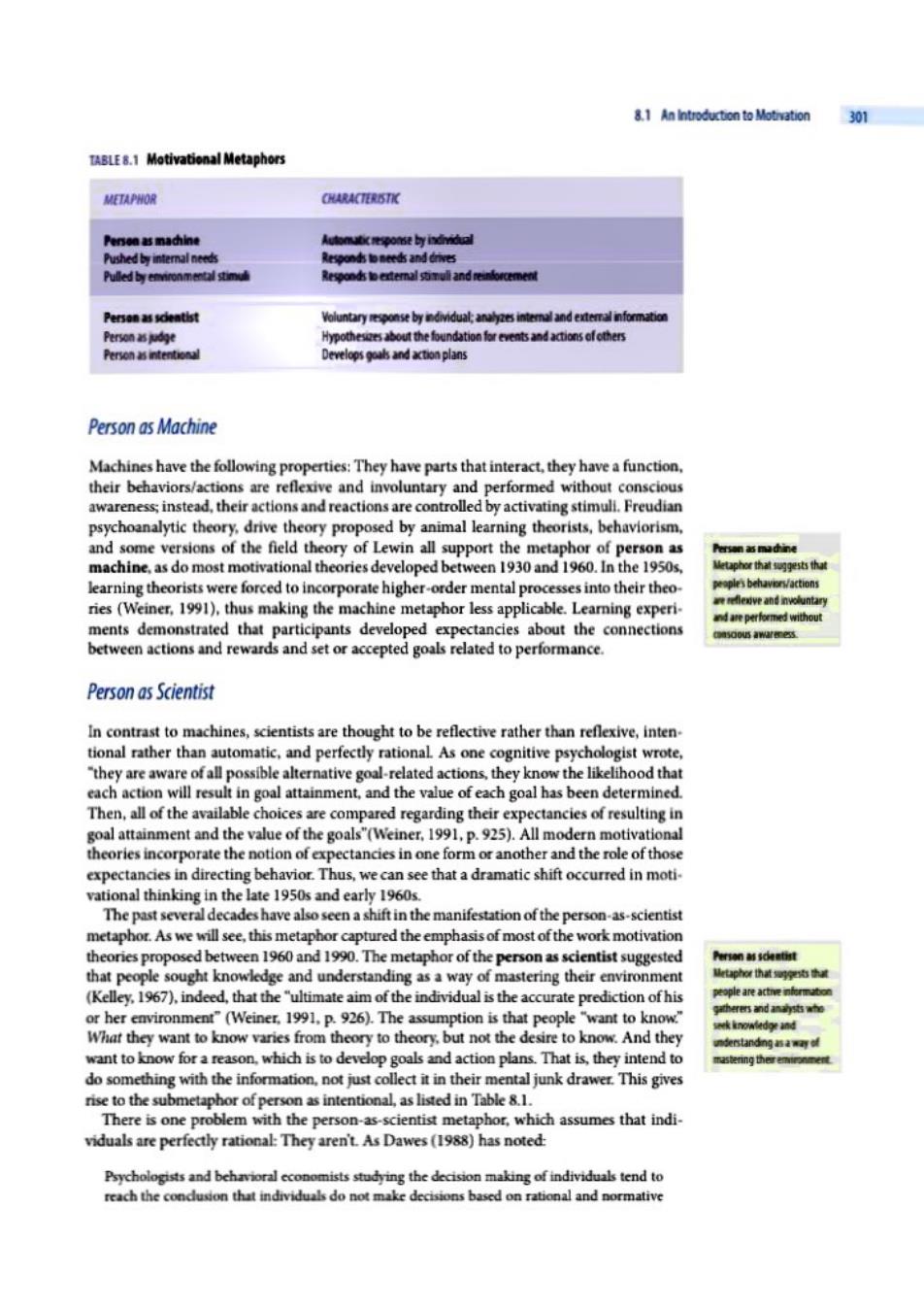
8.1 An Iintroduction to Motivation 301 TABLE 8.1 Motivational Metaphors METAPHOR C4城4ER5T Persen as machine Automaticpos by indnidual Pushed by interal needs Responds to needs and drive西 Pulled by emvironmental stimul Responds to extemal stmul and reindorcement Person as sdenti时 Voluntary nsby individual:anayentemandextemnf PoMs肉e Hypothesesabout the foundationfor eventsand actons ofothers Person as intentional Develops goals and action plans Person as Machine Machines have the following properties:They have parts that interact,they have a function. their behaviors/actions are reflexive and involuntary and performed without conscious awareness;instead,their actions and reactions are controlled by activating stimuli.Freudian psychoanalytic theory.drive theory proposed by animal learning theorists,behaviorism. and some versions of the field theory of Lewin all support the metaphor of person as machine,as do most motivational theories developed between 1930 and 1960.In the 1950s, learning theorists were forced to incorporate higher-order mental processes into their theo- eaples behavioes/actions ries(Weiner,1991),thus making the machine metaphor less applicable.Leaming experi- are eflexve and involuntary n同e perfoeme时without ments demonstrated that participants developed expectancies about the connections asoous awareness. between actions and rewards and set or accepted goals related to performance. Person as Scientist In contrast to machines,scientists are thought to be reflective rather than reflexive,inten- tional rather than automatic,and perfectly rational As one cognitive psychologist wrote, they are aware ofall possible alternative goal-related actions,they know the likelihood that each action will result in goal attainment,and the value of each goal has been determined. Then,all of the available choices are compared regarding their expectancies of resulting in goal attainment and the value of the goals"(Weiner,1991.p.925).All modern motivational theories incorporate the notion of expectancies in one form or another and the role of those expectancies in directing behavior.Thus,we can see that a dramatic shift occurred in moti- vational thinking in the late 1950s and early 1960s. The past several decades have also seen a shift in the manifestation of the person-as-scientist metaphot.As we will see,this metaphor captured the emphasis of most of the work motivation theories proposed between 1960 and 1990.The metaphor of the person as scientist suggested Person as scientist that people sought knowledge and understanding as a way of mastering their environment (Kelley,1967),indeed,that the"ultimate aim of the individual is the accurate prediction of his hg的ndan由e or her environment"(Weiner,1991,p.926).The assumption is that people "want to know." klnoaded年d What they want to know varies from theory to theory.but not the desire to know.And they want to know for a reason,which is to develop goals and action plans.That is,they intend to do something with the information,not just collect it in their mental junk drawer.This gives rise to the submetaphor of person as intentional,as listed in Table 8.1. There is one problem with the person-as-scientist metaphor,which assumes that indi- viduals are perfectly rational:They aren't.As Dawes(1988)has noted: Psychologists and behavioral economists studying the decision making of individuals tend to reach the condusion that individuals do not make decisions based on rational and normative